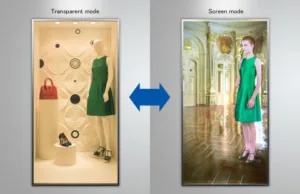Panasonic has developed a technology that can use a transparent glass screen as a projection screen, using a high contrast light control film embedded between the two layers of the glass. The layer can be switched from transparent to a screen mode. A special control box simultaneously operates a projector, to keep the images and screen synchronised. It can also control the lighting on the content in the transparent mode.
The control layer can be programmed to change the level of light transmission, allowing for use of the screen in a variety of different lighting situations, or at different times of day. The high contrast light control film is comprised of a transparent-cloudy white switching layer containing special polymers and capsules and a colour hue control layer. The colour hue control layer will absorb a great deal of external light in screen mode, thereby significantly reducing image degradation and bringing to life high contrast images on par with digital signage, even in brightly lit environments.
Panasonic said that multiple units can be used together to create larger displays. Contrast is quoted as 150:1 in the screen mode, while in the transparent mode, 70% transmission is achieved.
Analyst Comment
The layers use Liquid Crystal materials and similar technologies have been shown at CES over the last couple of years. Panasonic didn’t provide pricing or availability details. The firm expects applications in commercial sites, museums and hospitality as well as retail environments. There’s a video below.
Key features]
1. Reproduces high contrast images onto a large transparent glass
2. Serves as a show window displaying products and exhibits clearly
3. Numerous screens may be combined and controlled as a single large screen system
[Developmental background]
The demand among stores, shopping malls, museums, hotels, airports, and tourist information centers for a captivating exhibition service using digital signage is on the rise. Panasonic has received many requests for a system that would be capable of displaying high resolution images as digital signage and blend into the exhibition environment when not in use to create an alluring environment.
Panasonic applied the wealth of high resolution technologies it has fostered in the development of TVs and displays to create a transparent screen that could use the glass window as high resolution signage and provide a clear view of products and exhibits behind the glass when not in use as a screen.
[Key features]
1. Reproduces high contrast images onto a large transparent glass
1) Realizes high contrast images by absorbing external light
Traditionally, images have been projected onto cloudy white, electric switchable glass, but this type of glass was incapable of displaying high contrast images due to image degradation caused by external light.
Panasonic has combined glass with a high contrast light control film, which is comprised of a transparent-cloudy white switching layer containing special polymers and capsules and a color hue control layer. The color hue control layer will absorb a great deal of external light in screen mode, thereby significantly reducing image degradation and bringing to life high contrast images on par with digital signage, even in brightly lit environments.
2) Can optimize image quality according to the installation environment
By adjusting the color hue control layer’s permeability depending on the level of lighting in the installation environment, the screen can maintain the same level of high contrast in environments of varying brightness. In brightly lit spaces, it can reproduce images with rich blacks, and in dark environments, it can reproduce high contrast images even with a compact projector.
2. Serves as a show window displaying products and exhibits clearly
In the transparent mode, voltage is applied to the transparent – cloudy white switching layer which will give regularity to the arrangement of the light crystal molecules inside, thereby enabling the light to directly pass through. Moreover, by applying the maximum voltage to the color hue control layer, the permeability of the high contrast light control film will be improved.
With the anti-reflective (AR) film (optional) on the surface of the glass that reduces unwanted glare, Panasonic has realized a permeability of approximately 68%. This enables the glass to serve as a shop window, giving a clear view of products and exhibits behind the glass.
3. Numerous screens may be combined and controlled as a single large screen system
Numerous screens may be combined horizontally, so for example, a 221-inch (16:9) screen measuring 4.9m wide and 2.75m tall can be created.
The control box will switch between transparent and screen modes, control the projector, and turn ON/OFF the lighting in the exhibition space behind the glass.
About Panasonic
Panasonic Corporation is a worldwide leader in the development of diverse electronics technologies and solutions for customers in the consumer electronics, housing, automotive, enterprise solutions and device industries. Since its founding in 1918, the company has expanded globally and now operates 474 subsidiaries and 94 associated companies worldwide, recording consolidated net sales of 7.553 trillion yen for the year ended March 31, 2016. Committed to pursuing new value through innovation across divisional lines, the company uses its technologies to create a better life and a better world for its customers. To learn more about Panasonic: http://www.panasonic.com/global.

